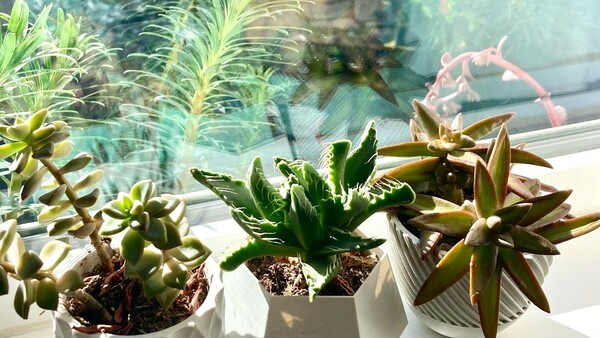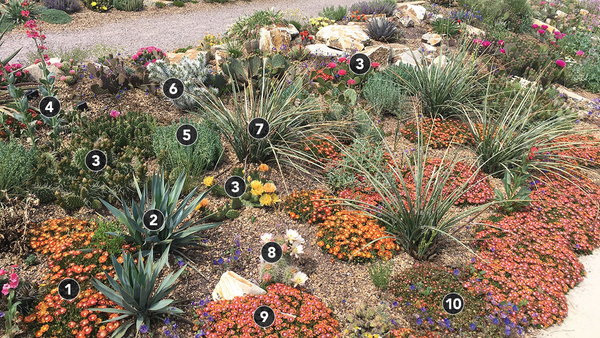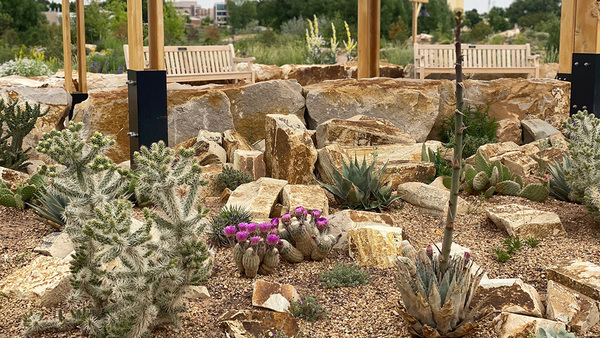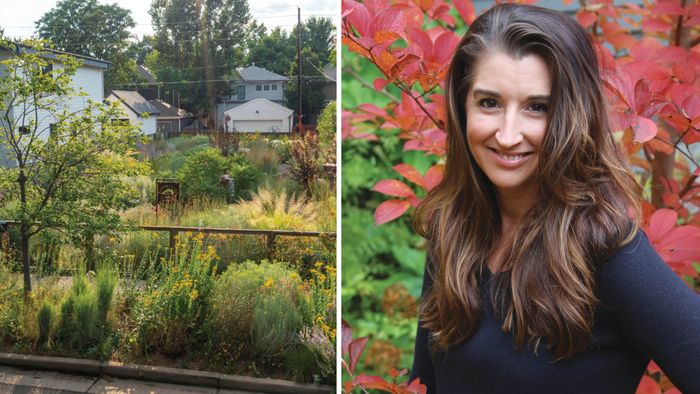
Many succulents, including cacti, can survive outdoors where winters are cold. These long-lived plants bring four seasons of living sculpture to a sunny, well-drained garden, and they offer up striking flowers to a variety of pollinators during the growing season. Recently, cacti and succulents have reigned supreme as houseplants, leading to a renewed passion for indoor gardening.
Two main reasons for their popularity are their uniquely appealing architectural shapes and symmetry, and the fact that they can thrive with little water or care. But these striking water-wise plants aren’t just for sunny windowsills or people who live in the desert. The following options are undemanding as long as you meet their basic needs, and they are perfect for xeric landscapes where drought is a concern.
See the plant id’s in the captivating combination above by clicking here.
What’s the difference between cacti and succulents?
The term succulent is not a botanical classification; rather, it is used to describe any plant that stores a lot of moisture in swollen stems and/or leaves. Cacti are a particular type of succulent. They belong to a botanical family, Cactaceae, that is comprised of related species of plants with succulent stems and generally no foliage. In many cactus species, the foliage has evolved and been modified into spines. Most cactus species inhabit dry -regions in the wild, where their spines help to shade them from -intense sun, prevent desiccation, and provide protection from hungry and thirsty foraging animals.
Cool Cacti

‘Snow Leopard’ Whipple’s cholla has unique white spines that are striking up close or from afar
Name: Cylindropuntia × multigeniculata ‘Snow Leopard’ syn. Cylindropuntia whipplei ‘Snow Leopard’
Zones: 5–9
Size: 1 to 4 feet tall and 2 to 4 feet wide
Conditions: Full sun; well-drained soil
Native range: Southwestern United States
‘Snow Leopard’ Whipple’s cholla, also called white-spined cholla, is one of the largest cold-hardy cacti out there and has a dramatic presence. Its succulent, many-branched cylindrical stems are armed with glistening white spines, which can make it look almost like an animal at a distance. In early summer, greenish-yellow flowers open and attract native bees. Bright yellow fruits follow that dry out and persist through winter. Give ‘Snow Leopard’ a sunny, wind-protected spot in colder, moister regions. It can thrive along house foundations under the eaves on the south or southwest side. In milder, drier regions, plant this stunning cactus out in the open where low morning or afternoon sun can backlight its extraordinary texture and form.

‘Coombe’s Winter Glow’ prickly pear wows even in winter

Name: Opuntia aurea ‘Coombe’s Winter Glow’
Zones: 4b–9
Size: 1 to 2 feet tall and 2 to 4 feet wide
Conditions: Full sun; well-drained soil
Native range: Southern Utah, northern Arizona
This handsome, heavy-textured cactus has large, paddle-shaped pads like a beaver’s tail. They are gray-green during the growing season but turn rich plum-purple in winter (right). Though almost spineless, the pads sport tiny, irritating, hairlike glochids that are barely visible and come off at the lightest touch. They can embed in skin, so use barbecue tongs when handling this plant and avoid all but the thickest gloves, as the glochids can poke through thinner ones. In early summer ‘Coombe’s Winter Glow’ prickly pear blooms with lusciously large dark pink flowers (top). Pads root when they have contact with soil, which allows this cactus to expand to a beefy, broad size in only a few years. Several mammals and bird species also eat the fruit and seeds of this cactus.

Diminutive Simpson’s hedgehog cactus blooms early with bubblegum-pink flowers
Name: Pediocactus simpsonii
Zones: 3–7
Size: 2 to 6 inches tall and 3 to 6 inches wide
Conditions: Full sun to partial shade; well-drained soil
Native range: Western United States
This adorable cactus is perfectly round. Its dense, fine spines vary from brown to pure white. One of the earliest plants to bloom (in early to midspring), it opens to a clustered bouquet of typically pink—more rarely cream or pale yellow—flowers at its top that attract eager bees. In summer this plant prefers some afternoon shade at hotter, lower elevations. Simpson’s hedgehog cactus, also called snowball cactus, grows into a small, solitary specimen, so it needs an intimate space to show off its cuteness. Frame it with a rock, or site it in a crevice garden or a winter-proof container. This beauty often seeds itself in loose soil and gravel mulch, eventually forming a small, droll pack.

Choose spineless claret cup cactus to avoid pricking your fingers
Name: Echinocereus triglochidiatus var. mojavensis f. inermis
Zones: 4b–9
Size: 3 to 8 inches tall and 10 to 15 inches wide
Conditions: Full sun; well-drained soil
native range: Southwestern United States, northeastern Baja California
This thornless form of the beloved claret cup cactus makes a unique and less prickly accent plant. Its bright green, short cylindrical stems sport patterns of flashy white-felted bumps, where spines protrude in other forms. Like all claret cups, this cactus unfurls a springtime crown of brilliant red flowers with prominent lime-green pistils that attract all sorts of pollinators, including hummingbirds. Individual flowers last for several days, unlike some cactus flowers that wilt after only one. This compact beauty deserves placement as a main attraction in rock gardens, crevice gardens, and other similar settings where close viewing is encouraged.

Spinystar cacti can vary in form and spine color
Name: Escobaria vivipara
Zones: 4–8
Size: 2 to 6 inches tall and 4 to 15 inches wide
Conditions: Full sun; well-drained soil
Native range: Western and central North America
Spinystar (or pincushion) cactus is a showy small plant with various shapes; typically it grows as a solitary, small, barrel-shaped stem up to 4 inches in diameter, but some forms cluster by sprouting baby stems that produce a multitude of tiny, dense, spiny balls. These balls form bumpy clumps a foot or more across. Spines can be white, gray, tan, brown, or black. In late spring, large, pointy-tipped bright pink flowers open, making a striking floral crown that can easily be seen from a distance by pollinators and people alike. The fruit is green and tasty. Plant this small gem in a rock or crevice garden or in a winter-proof container or trough.
Succulents

Banana yucca’s curly white filaments create an unusual texture
Name: Yucca baccata
Zones: 4b–11
Size: 2 to 3 feet tall and 3 to 6 feet wide
Conditions: Full sun; well-drained soil
Native range: Southwestern and south-central United States
Banana yucca is the boldest hardy yucca, with broad, swordlike foliage. The leaves are often curved, even curled, and can be powder blue, gray, or olive green. White fibers along their edges delightfully catch light, frost, and snowflakes. Over time, banana yucca makes a cluster of mature foliage rosettes. In early summer, luxuriant spikes of large, waxy, bell-shaped white flowers rise up on stems from 3 to 5 feet tall. Fleshy, edible fruit that looks like short green bananas follows, giving this plant its common name. This large succulent fits well into an easy-care dryland planting, where its strongly sculptural form can contrast with finer textures. Many gardeners “dehorn” this yucca for safety, cutting off the leaves’ spiny tips.

The beautiful flowers of turquoise tails sedum are only outdone by its striking teal foliage
Name: Sedum sediforme
Zones: 5–10
Size: 6 to 12 inches tall and 12 to 18 inches wide
Conditions: Full sun; well-drained soil
Native range: Mediterranean regions of Asia, Europe,
and Africa
This hardy evergreen succulent resembles the popular tender burro’s tail sedum (S. morganianum, Zones 10–11) but is a bit more upright. The plump blue-green leaves are densely arranged in whorls along the stems. In the dog days of summer, clusters of creamy star-shaped flowers bloom on tall stems, attracting droves of bees. This plant can be up to 18 inches tall when in bloom. Turquoise tails sedum does well in my Zone 4b Colorado garden. It is one of the most drought resistant of all sedums and works well as an edge plant. It can also be grown on slopes, in roof gardens, or in rock gardens with larger cacti.

‘Greenii’ hens and chicks provides an eye-catching contrast of red and green
Name: Sempervivum calcareum ‘Greenii’
Zones: 4–9
Size: 4 to 6 inches tall and 12 inches wide
Conditions: Full sun to partial shade; well-drained soil
Native range: Southwestern Alps in Italy and France
Longtime pass-along plants, hens and chicks make offsets that allow for easy sharing. Historically these succulents were thought to offer protective properties when planted near a house or on a roof. Their easy care and charming looks continue to add to their popularity in our less superstitious times. ‘Greenii’ is a large, extra-hardy, and robust selection, with fresh-looking green rosettes that are red-tipped. Hens and chicks can sunburn in hot midday and afternoon sun, as they hail from cool, high elevations in the Alps, so dappled shade or morning sun is best in hot, sunny climates. Clusters of starry flowers bloom in summer, attracting bees. The flower-bearing rosette then dies, but offsets grow on to bloom at maturity, and so the cycle continues.


Name: Delosperma nubigenum
Zones: 4–9
Size: 1 to 3 inches tall and 9 to 18 inches wide
Conditions: Full sun; well-drained soil
Native range: South Africa
Of the many ice plants in the trade, this species is the most cold hardy. Masses of iridescent, starry yellow daisies open in late spring, attracting bees and almost completely hiding the low carpet of lime green, sausage-shaped leaves. This ground-covering plant spreads quickly but has shallow roots, so it’s simple to pull out when it gets too rambunctious. The evergreen foliage turns a phenomenal raspberry red in winter. Hardy yellow ice plant is easy to propagate from cuttings or division and is one of the best choices for firewise landscapes. It does best in climates with low humidity and cool nights.

Delicate blooms nod above the distinctive leaves of fame flower
Name: Phemeranthus calycinus
Zones: 5–9
Size: 6 to 9 inches tall and 9 to 12 inches wide
Conditions: Full sun; well-drained soil
Native range: South-central United States
Fame flower, also called rock pink, is dainty yet tough, with green tufts of fingerlike foliage that are evergreen in milder zones. In late spring, almost invisible threadlike stems rise 6 to 10 inches above the leaves, with myriad little rose-pink flowers at their tips. The blossoms float above the foliage, adding a lively, sprightly air to more staid and solid-looking designs. They continue blooming for most of the summer and into fall if the plant gets periodic irrigation. This succulent flowers best in hot, sunny locations. It self-sows, but seedlings are easy to pull, move, or share, thanks to their short, solitary roots.
| Design Ideas |
Fine textures and contrasting colors create a dynamic, drought-tolerant display
This planting mixes a succulent with other plants that require minimal irrigation for easy-care beauty that shines in the midst of hot, dry summers. On a warm, sunny sidewalk’s edge at Chatfield Farms near Denver, creamy flower clusters of turquoise tails sedum front this pleasantly surprising design during the tiresome dog days of summer. English lavender, the wispy tan seedheads of Mexican feather grass, and a few remaining yellow coneflowers work together to create a combination that is as much about texture as it is about contrasting color, with participants looking good in winter as well as in late July.
Except for the slightly thirstier coneflower, these plants need minimal irrigation. However, they all can adapt and thrive in areas with more rain as long as the soil has good drainage. Removing spent flowers in late summer, cutting the grass to the ground in early spring, and performing some postwinter pruning and shaping of the lavender is all the care this planting needs.

1. Turquoise tails sedum
2. English lavender (Lavandula angustifolia, Zones 5–10)
3. Mexican feather grass (Nassella tenuissima, Zones 6–10)
4. Yellow coneflower (Echinacea paradoxa, Zones 5–8)
Lauren Springer is a horticulturist, author, and garden designer based in Fort Collins, Colorado.
Sources
The following mail-order retailers offer many of the plants featured in this article:
• Planet Desert, Fallbrook, CA; 707-937-2651; planetdesert.com
• Cold Hardy Cactus Nursery, Lakewood, CO; 720-628-2518; coldhardycactus.com
• Mountain Crest Gardens, Fort Jones, CA; 877-656-4035; mountaincrestgardens.com
• High Country Gardens, Clinton, UT; 800-925-9387; highcountrygardens.com
Fine Gardening Recommended Products

Gardener's Log Book from NYBG
Fine Gardening receives a commission for items purchased through links on this site, including Amazon Associates and other affiliate advertising programs.

ARS Telescoping Long Reach Pruner
Fine Gardening receives a commission for items purchased through links on this site, including Amazon Associates and other affiliate advertising programs.

Sun Joe Cordless Telescoping Pole Chain Saw
Fine Gardening receives a commission for items purchased through links on this site, including Amazon Associates and other affiliate advertising programs.



















Comments
Log in or create an account to post a comment.
Sign up Log in